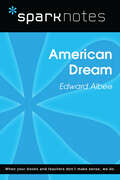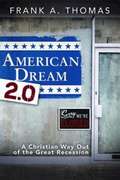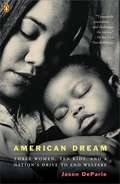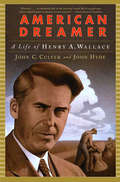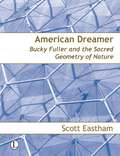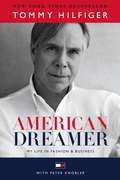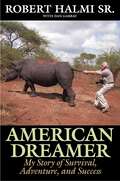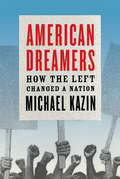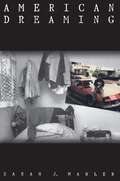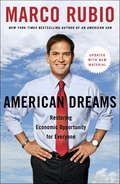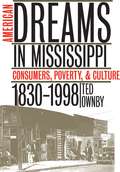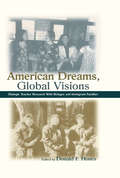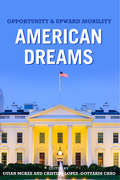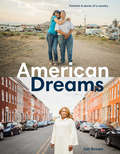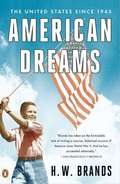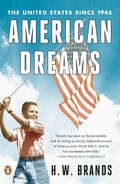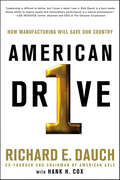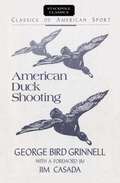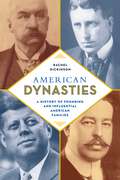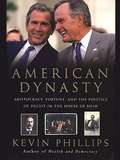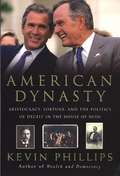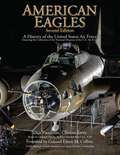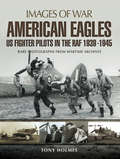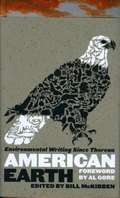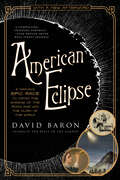- Table View
- List View
American Dream (SparkNotes Literature Guide Series)
by SparkNotesAmerican Dream (SparkNotes Literature Guide) by Edward Albee Making the reading experience fun! Created by Harvard students for students everywhere, SparkNotes is a new breed of study guide: smarter, better, faster.Geared to what today's students need to know, SparkNotes provides:*chapter-by-chapter analysis *explanations of key themes, motifs, and symbols *a review quiz and essay topics Lively and accessible, these guides are perfect for late-night studying and writing papers.
American Dream 2.0: A Christian Way Out of the Great Recession
by Frank A. ThomasThe promise of America has always been creative potential: enterprise, industry, optimism, idealism, and hope. This promise, known since the beginning of the New World and named since the Great Depression as the "American Dream", is what makes immigrants cry at the base of the Statue of Liberty. But there is a dark side to the American Dream, too—one that we don’t talk about much in polite company. A side characterized by the exploitation and domination of subjected people.The national climate has caused many to question the validity of the American Dream, and whether it even offers a viable vision for the nation. There are few greater questions to ask. Our collective future depends on a common vision. If the American Dream is dead, then what happens next?This book evaluates the American Dream, establishes its roots, gives reasons for its decline, and offers solutions to reclaim the promise of the American Dream that is more aligned with Jesus’ vision of the kingdom of God and Martin Luther King Jr’ s vision of the "Beloved Community". Our challenge is to develop a redesigned American Dream, a sustainable future for all, free from exploitation and domination of subjected people.
American Dream: Three Women, Ten Kids, and a Nation's Drive to End Welfare
by Jason DeparleIn this definitive work, two-time Pulitzer finalist Jason DeParle cuts between the mean streets of Milwaukee and the corridors of Washington to produce a masterpiece of literary journalism. At the heart of the story are three cousins whose different lives follow similar trajectories. Leaving welfare, Angie puts her heart in her work. Jewell bets on an imprisoned man. Opal guards a tragic secret that threatens her kids and her life. DeParle traces their family history back six generations to slavery and weaves poor people, politicians, reformers, and rogues into a spellbinding epic. With a vivid sense of humanity, DeParle demonstrates that although we live in a country where anyone can make it, generation after generation some families don't. To read American Dream is to understand why.
American Dreamer: A Life of Henry A. Wallace
by John Hyde John C. CulverThe great politician, agriculturalist, economist, author, and businessman--loved and reviled, and finally now revealed. The great politician, agriculturalist, economist, author, and businessman--loved and reviled, and finally now revealed. The first full biography of Henry A. Wallace, a visionary intellectual and one of this century's most important and controversial figures. Henry Agard Wallace was a geneticist of international renown, a prolific author, a groundbreaking economist, and a businessman whose company paved the way for a worldwide agricultural revolution. He also held two cabinet posts, served four tumultuous years as America's wartime vice president under FDR, and waged a quixotic campaign for president in 1948. Wallace was a figure of Sphinx-like paradox: a shy man, uncomfortable in the world of politics, who only narrowly missed becoming president of the United States; the scion of prominent Midwestern Republicans and the philosophical voice of New Deal liberalism; loved by millions as the Prophet of the Common Man, and reviled by millions more as a dangerous, misguided radical. John C. Culver and John Hyde have combed through thousands of document pages and family papers, from Wallace's letters and diaries to previously unavailable files sealed within the archives of the Soviet Union. Here is the remarkable story of an authentic American dreamer. A Washington Post Best Book of the Year. 32 pages of b/w photographs. "A careful, readable, sympathetic but commendably dispassionate biography."--Arthur Schlesinger, Jr., Los Angeles Times Book Review "In this masterly work, Culver and Hyde have captured one of the more fascinating figures in American history."--Doris Kearns Goodwin, author of No Ordinary Time "Wonderfully researched and very well written...an indispensable document on both the man and the time."--John Kenneth Galbraith "A fascinating, thoughtful, incisive, and well-researched life of the mysterious and complicated figure who might have become president..."--Michael Beschloss, author of Taking Charge: The Johnson White House Tapes, 1963-1964 "This is a great book about a great man. I can't recall when--if ever--I've read a better biography."--George McGovern "[A] lucid and sympathetic portrait of a fascinating character. Wallace's life reminds us of a time when ideas really mattered."--Evan Thomas, author of The Very Best Men: The Early Years of the CIA "Everyone interested in twentieth-century American history will want to read this book."--Robert Dallek, author of Flawed Giant "[T]he most balanced, complete, and readable account..."--Walter LaFeber, author of Inevitable Revolutions "At long last a lucid, balanced and judicious narrative of Henry Wallace...a first-rate biography."--Douglas Brinkley, author of The Unfinished Presidency "A fine contribution to twentieth-century American history."--James MacGregor Burns, author of Dead Center: Clinton-Gore Leadership and the Perils of Moderation "[E]minently readable...a captivating chronicle of American politics from the Depression through the 1960s."--Senator Edward M. Kennedy "A formidable achievement....[an] engrossing account."--Kai Bird, author of The Color of Truth: McGeorge Bundy & William Bundy, Brothers in Arms "Many perceptions of Henry Wallace, not always favorable, will forever be changed."--Dale Bumpers, former US Senator, Arkansas
American Dreamer: Bucky Fuller and the Sacred Geometry of Nature
by Scott EasthamSynergetics can be defined as the exploratory strategy of starting with the whole. It was in the 1940s that Buckminster Fuller developed a series of spherical models which embodied the synergetic theory within geometry. This study of Fuller's sacredgeometry describes with vigour and in detail how his spherical figures relate both to Nature and to the tenets of synergetics. The author assesses the legacy of Fuller, a scientist-artist-engineer extraordinaire whose visions were inspired by the American Dream, and portrays with enthusiasm and sympathy the creative and individual science of a man whose character was as multifaceted as the domes he created. Discover the theory behind the idea that the straight lines and boxes of science and maths are inadequate for representing Nature's spherical and cyclical patterns of growth. The ways in which Fulleris synergetics can be seen in the ancient iconographies of the past are also revealed with fresh insight. In addition, Eastham looks to thefuture artistic applications of Fuller's wholes, with the aim of inspiring the reader to think outside of the box themselves. 'We sought for years to bring out a brief alternative geometry textbook. [...] It's not easy to produce a round thing ina square world...' Extract from the Introduction.
American Dreamer: My Life in Fashion & Business
by Quincy Jones Peter Knobler Tommy HilfigerIn this tale of grit and glamour, setbacks and comebacks, business and pop culture icon Tommy Hilfiger shares his extraordinary life story for the first time. Few designers have stayed on top of changing trends the way Tommy Hilfiger has. Fewer still have left such an indelible mark on global culture. Since designing his first collection of "classics with a twist" three decades ago, Tommy Hilfiger has been synonymous with all-American style--but his destiny wasn't always so clear. Growing up one of nine children in a working-class family in Elmira, New York, Tommy suffered from dyslexia, flunked sophomore year of high school, and found himself constantly at odds with his father. Nevertheless, this self-described dreamer had a vision and the relentless will to make it a reality. At eighteen he opened his own clothing store, parlaying his uncanny instinct for style into a budding career as a fashion designer. Through decades of triumph and turmoil, Tommy remained doggedly optimistic. To this day, his approach to commerce is rooted in his positive view of the world.American Dreamer brims with anecdotes that cover Tommy's years as a club kid and scrappy entrepreneur in 1970s New York as well as unique insights into the exclusive A-list personalities with whom he's collaborated and interacted, from Mick Jagger and David Bowie to Ralph Lauren and Calvin Klein. But this is more than just a fashion icon's memoir--it's a road map for building a brand, both professionally and personally. Tommy takes us behind the scenes of every decision--and every mistake--he's ever made, offering advice on leadership, business, team-building, and creativity. This is the story of a true American original, told for the first time in his own words, with honesty, humor, and the insatiable appetite for life and style that proves that sometimes you have to dream big to make it big. Advance praise for American Dreamer "Tommy burst onto the fashion scene at the height of hip-hop and was instantly taken up by rappers and rockers alike. Since then, year after year he has been ahead of the curve with his elegant and stylish looks. His creative energy has always been an inspiration to me. He's really himself in American Dreamer."--Mick Jagger "Whenever I think of Tommy Hilfiger, I think of a designer who has been able to wrap fashion in the American flag. In American Dreamer Tommy shows how he has taken the (rock) stars and the (preppy) stripes and come up with a look--and a label--that are recognized globally as being quintessentially American, as well as a brand that constantly keeps time with pop music."--Anna Wintour "Tommy is an inspiration to many people. American Dreamer shows how he has managed to be successful in business and done so with integrity. I have come to know Tommy, and every time we talk I learn something new about creating a successful business."--David Beckham "Tommy is one of the most genuine people I know! In American Dreamer you can feel his passion pour through everything he does: fashion, fatherhood, family, and friendship!"--Alicia Keys "Tommy Hilfiger is an American icon who was able to transcend fashion and blend it with pop culture and take it to a worldwide audience. American Dreamer documents how, unlike any other designer, Tommy was able to tap into music, its subculture, and its influence on society, which propelled his fashion to be mainstream and global."--Tommy MottolaFrom the Hardcover edition.
American Dreamer: My Story of Survival, Adventure, and Success
by Robert HalmiOn July 30, 2014, shortly after completing this autobiography, Robert Halmi, the prolific producer of television movies and miniseries, died at the age of 90. Hailed by Variety as &“A Gulliver Among TV Movie Producers,&” he had a hand in more than 200 long-form narrative television projects from 1989&’s Lonesome Dove, starring Robert Duvall, to 2000&’s &“Don Quixote&” starring John Lithgow. Filled with so much of the marquee talent of the past century, his life story—from fighting against the Nazis to becoming a photographer for Life and Sports Illustrated to his television work—is truly amazing.Robert Halmi was born in Hungary to a father who served as official photographer to the Vatican and the last Habsburg court. When the Nazis invaded, he fought in the resistance, and like many of his countrymen he was captured and condemned to death. But the advancing Red Army freed him before the Germans could carry out the execution. Seeing the dangers of the expanding Soviet empire, which also took hold of his homeland in a military dictatorship, he turned heel and joined the OSS to fight the fall of the Iron Curtain. In 1951, with $5 in his pocket and a Leica around his neck, he made his way to America. As a photographer for Life and Sports Illustrated, he again showcased his Bond-like talents for chasing adventure and cheating death by dangling from helicopters, hunting big game in Africa with dictators, blowing himself up, marooning himself on a glacier for three weeks, and even painting Marilyn Monroe&’s naked body for a photo shoot. In the third act of his rollicking life, as a TV mogul, he received an astonishing 448 Emmy nods while befriending a Who&’s Who of Hollywood and working with the great boldface actors of our time: Jimmy Cagney gave him his last performance. He chased George C. Scott (on a bender) through a hotel. Omar Sharif did the Twist for him. He watched Patrick Stewart nearly drown on the back of an animatronic whale, and Isabella Rossellini braved a herd of rampaging elephants for him. He has lived the American dream to the hilt. A fast-paced look back at a life always in progress, his extraordinary story reveals nearly a century of daring and boundless optimism even in the face of terrible odds. It&’s a story of war, love, and ambition, the quintessential American tale of a life lived large.
American Dreamers: How the Left Changed a Nation
by Michael KazinA panoramic yet intimate history of the American left--of the reformers, radicals, and idealists who have fought for a more just and humane society, from the abolitionists to Michael Moore and Noam Chomsky--that gives us a revelatory new way of looking at two centuries of American politics and culture. Michael Kazin--one of the most respected historians of the American left working today--takes us from abolitionism and early feminism to the labor struggles of the industrial age, through the emergence of anarchists, socialists, and communists, right up to the New Left in the 1960s and '70s. While the history of the left is a long story of idealism and determination, it has also been, in the traditional view, a story of movements that failed to gain support from mainstream America. In American Dreamers, Kazin tells a new history: one in which many of these movements, although they did not fully succeed on their own terms, nonetheless made lasting contributions to American society that led to equal opportunity for women, racial minorities, and homosexuals; the celebration of sexual pleasure; multiculturalism in the media and the schools; and the popularity of books and films with altruistic and antiauthoritarian messages. Deeply informed, at once judicious and impassioned, and superbly written, American Dreamers is an essential book for our times and for anyone seeking to understand our political history and the people who made it.From the Hardcover edition.
American Dreaming: Immigrant Life on the Margins
by Sarah J. MahlerAmerican Dreaming chronicles in rich detail the struggles of immigrants who have fled troubled homelands in search of a better life in the United States, only to be marginalized by the society that they hoped would embrace them. Sarah Mahler draws from her experiences living among undocumented Salvadoran and South American immigrants in a Long Island suburb of Manhattan. In moving interviews they describe their disillusionment with life in the United States but blame themselves individually or as a whole for their lack of economic success and not the greater society. As she explores the reasons behind this outlook, the author argues that marginalization fosters antagonism within ethnic groups while undermining the ethnic solidarity emphasized by many scholars of immigration. Mahler's investigation leads to conditions that often bar immigrants from success and that they cannot control, such as residential segregation, job exploitation, language and legal barriers, prejudice and outright hostility from their suburban neighbors. Some immigrants earn surplus income by using private cars as taxis, subletting space in apartments to lower rent burdens, and filling out legal forms and applications--in essence generating institutions largely parallel to those of the mainstream society whereby only a small group of entrepreneurs can profit. By exacting a price for what used to be acts of reciprocal good will in the homeland, these entrepreneurs leave people who had expected to be exploited by "Americans" feeling victimized by their own.
American Dreams
by Senator Marco RubioDear Friends, My parents came to the United States in 1956. The country they found was truly a land of opportunity, where hardworking people with grade school educations could afford a home, a car, and college for their kids. A country where maids and bartenders could raise doctors, lawyers, small-business owners, and maybe even a U.S. senator. That was the American Dream--our country's central promise to its people: If you work hard and play by the rules, you'll find tremendous opportunities and an even better life for your children. Yet today, I look around and see the American Dream on life support. Seven years of government-centered, tax-and-spend liberalism have failed to lift the poor or sustain the middle class. Fewer Americans are working than at any time since Jimmy Carter was president. New business creation is 30 percent lower than it was in the 1980s. The stock market may be surging by the time you read this, but millions of everyday Americans will still be left behind by an economy that doesn't value their skills and a government that would rather give a handout than a hand up. I wrote this book because we stand at a critical juncture. What kind of country are we going to be? Will we surrender to Obamacare and other laws that crush innovation and entrepreneurship? Will we accept a powerful nanny state and the erosion of family values? Will we allow politics to kill the American Dream? Or will we rise to the challenge--and take back our legacy as the only nation on earth that offers unrestricted opportunity to all? I believe we can restore the American Dream and expand it to reach more people than ever before. But to do so we must restrain our power-hungry, debt-ridden federal government. We must help businesses create more stable middle-class jobs. And we must help our families stay healthy and secure. In this book you'll meet an over-regulated small-businessman, a struggling single mother, an out-of-work and in-debt college graduate, and others who want nothing more than their own shot at the American Dream. Their stories are our stories; their challenges are our challenges. Of course no book or politician can single-handedly restore the American Dream. But a movement, working to promote the values and can-do spirit that made our country exceptional, can turn everything around. My goal is to provide a roadmap for that movement and inspire Americans to reclaim their rights: to dream, to work, to build a better life for their children. I hope you will join me as we build that movement and restore the land of opportunity. Sincerely, Marco Rubio
American Dreams in Mississippi
by Ted OwnbyThe dreams of abundance, choice, and novelty that have fueled the growth of consumer culture in the United States would seem to have little place in the history of Mississippi--a state long associated with poverty, inequality, and rural life. But as Ted Ownby demonstrates in this innovative study, consumer goods and shopping have played important roles in the development of class, race, and gender relations in Mississippi from the antebellum era to the present. After examining the general and plantation stores of the nineteenth century, a period when shopping habits were stratified according to racial and class hierarchies, Ownby traces the development of new types of stores and buying patterns in the twentieth century, when women and African Americans began to wield new forms of economic power. Using sources as diverse as store ledgers, blues lyrics, and the writings of William Faulkner, Eudora Welty, Richard Wright, and Will Percy, he illuminates the changing relationships among race, rural life, and consumer goods and, in the process, offers a new way to understand the connection between power and culture in the American South.
American Dreams, Global Visions: Dialogic Teacher Research With Refugee and Immigrant Families (Sociocultural, Political, and Historical Studies in Education)
by Donald F. HonesThis book presents the struggle for dialogue and understanding between teachers and refugee and immigrant families, in their own words. Forging a stronger connection between teachers, newcomers, and their families is one of the greatest challenges facing schools in the United States. Teachers need to become familiar with the political, economic, and sociocultural contexts of these newcomers' lives, and the role of the U.S. in influencing these contexts in positive and negative ways. The important contribution of American Dreams, Global Visions is to bring together global issues of international politics and economics and their effects on migration and refugee situations, national issues of language and social policy, and local issues of education and finding ways to live together in an increasingly diverse society. Narratives of four immigrant families in the United States (Hmong, Mexican, Assyrian/Kurdish, Kosovar) and the teacher-researchers who are coming to know them form the heart of this work. The narratives are interwoven with data from the research and critical analysis of how the narratives reflect and embody local, national, and global contexts of power. The themes that are developed set the stage for critical dialogues about culture, language, history, and power. Central to the book is a rationale and methodology for teachers to conduct dialogic research with refugees and immigrants--research encompassing methods as once ethnographic, participatory, and narrative--which seeks to engage researchers and participants in dialogues that shed light on economic, political, social, and cultural relationships; to represent these relationships in texts; and to extend these dialogues to promote broader understanding and social justice in schools and communities. American Dreams, Global Visions will interest teachers, social workers, and others who work with immigrants and refugees; researchers, professionals, and students across the fields of education, language and culture, ethnic studies, American studies, and anthropology; and members of the general public interested in learning more about America's most recent newcomers. It is particularly appropriate for courses in foundations of education, multicultural education, comparative education, language and culture, and qualitative research.
American Dreams: Opportunity and Upward Mobility (Miller Center Studies on the Presidency)
by Peter Wehner Michael Nelson William A. Galston Margaret O'Mara Richard Schragger Melody Barnes Cristina Lopez-Gottardi Chao Guian McKee Robert C. PiantaIn an increasingly polarized political environment, the first year of the new president’s term will be especially challenging. With a fresh mandate, however, the first year also offers opportunities that may never come again. The First Year Project is a fascinating initiative by the Miller Center of the University of Virginia that brings together top scholars on the American presidency and experienced officials to explore the first twelve months of past administrations, and draw practical lessons from that history, as we inaugurate a new president in January 2017.This project is the basis for a new series of digital shorts published as Miller Center Studies on the Presidency. Presented as specially priced collections published exclusively in an ebook format, these timely examinations recognize the experiences of past presidents as an invaluable resource that can edify and instruct the incoming president.Contributors: Melody Barnes, New York University * William A. Galston, Brookings Institution * Dambisa Moyo, global economist and author * Michael Nelson, Rhodes College * Margaret O’Mara, University of Washington * Robert Pianta, University of Virginia * Richard Schragger, University of Virginia * Peter Wehner, Ethics and Public Policy Center
American Dreams: Portraits & Stories of a Country
by Ian BrownA powerful, moving collection of 170 portraits of Americans and their handwritten statements about what the American dream means to them.Shot by one photographer over twelve years, fifty states, and eighty thousand miles, American Dreams is a poignant, defining look at people from every walk of life and a remarkable exploration of what it means to be an American.Long fascinated by the idea of the &“American Dream,&” Canadian photographer Ian Brown set out to document, in photographs and words, what that dream means to Americans of all ages, races, identities, classes, religions, and ideologies. Over the course of twelve years, Brown traveled more than eighty thousand miles in an old truck, visiting all fifty states and connecting with hundreds of Americans. He knocked on people's doors; met them at town halls, diners, and factories; and approached them on main streets in small towns. He shot their portraits and asked them to write down their own American dreams. Their dreams and stories—which range from hopeful, moving, and optimistic to defiant, bitter, and heartbreaking—offer a fascinating, unparalleled perspective of the striking diversity and deep nuance of the American experience.
American Dreams: The United States Since 1945
by H. W. BrandsTHE STORY OF OUR NATION FROM THE A - BOMB TO THE iPHONE <p><p>For a brief moment in 1945, America stood at its apex, looking back on victory not only against the Axis powers but also against the Great Depression, and looking ahead to a seemingly limitless future. What we've done in the six decades since is a vitally important and fascinating topic that has rarely been tackled in one volume. Covering the highs and lows, politics to pop culture, H. W. Brands, one of today's preeminent historians, creates a character-driven narrative that chronicles the great themes and events that have driven America-a still unfolding legacy of dreams born out of a global cataclysm. <p> 'A crisp, balanced account of America. ' - THE ECONOMIST <p> 'Brands weaves together keen political history with anecdote and marvellous sense of place to produce a vivid tableau. ' - THE BOSTON GLOBE <p> 'Brands knows how to write narrative and how to make the complex comprehensible. ' - JONATHAN YARDLEY, THE WASHINGTON POST BOOK WORLD
American Dreams: The United States Since 1945
by H. W. BrandsFrom bestselling historian H. W. Brands, an incisive chronicle of the events and trends that guided-and sometimes misguided-our nation from the A-bomb to the iPhone. For a brief, bright moment in 1945, America stood at its apex, looking back on victory not only against the Axis powers but against the Great Depression, and looking ahead to seemingly limitless power and promise. What we've done with that power and promise over the past six decades is a vitally important and fascinating topic that has rarely been tackled in one volume, and never by a historian of H. W. Brands's stature. As American Dreams opens, Brands shows us a country dramatically different from our own-more unequal in social terms but more equal economically, more religious and rural but also more liberal and more wholeheartedly engaged with the rest of the world. As he traces the changes we have gone through as a nation, he reveals the great themes and dreams that have driven America-the rising focus on individual rights and pleasures, the growing distance between our global goals and those of the rest of the world, and the inexorable dissolution of a shared sense of what it means to be American. In Brands's adroit hands, these trends unfold through a character-driven narrative that sheds brilliant light on the obvious highs and lows-from Watergate to the Berlin Wall, from Apollo 11 to 9/11, from My Lai to shock and awe. But he also chronicles the surprising impact of less celebrated events and trends. Through his eyes, we realize the sweeping significance of the immigration reforms of the 1960s, which gradually transformed American society. We come to grasp the vast impact of abandoning the gold standard in 1971, which enabled both globalization and the current financial crisis. We ponder the unnerving results of CNN's debut in 1979, which sped up the news cycle and permanently changed our foreign policy by putting its effects live on our TV screens. Blending political and cultural history with his keen sense of the spirit of the times, Brands captures the national experience through the last six decades and reveals the still-unfolding legacy of dreams born out of a global cataclysm.
American Drive: How Manufacturing Will Save Our Country
by Hank H. Cox Richard E. DauchPoliticians, voters, executives, and employees all want the answer to one question: How can America compete with cheap foreign labor, and restore skilled, well-paying jobs to our economy? American Drive answers that question.An executive with nearly thirty years in the trenches of the hard-nosed Detroit automobile industry, Richard E. "Dick" Dauch had long dreamed of running his own manufacturing company. From his first job on the plant floor at General Motors to his crucial role in helping to rescue Chrysler from the brink of bankruptcy, Dauch focused passionately, and relentlessly, on quality, productivity, and flexibility in manufacturing. In 1993 he took on the challenge of his life, buying a lagging axle supply and parts business from GM, along with five rusting, unprofitable, union-controlled, near-decrepit plants in the heart of a crime-ridden Detroit and a deteriorating environment in Buffalo, New York.The newly created "stand-alone" company was named American Axle and Manufacturing. Dauch set out to create a world-class industrial automotive manufacturer. He bought and bulldozed the crack, liquor, and prostitution businesses that surrounded the company and rebuilt the plants. He upward educated, trained, and expanded the skill sets of the workforce, struck tough bargains with unions, and solved massive quality problems that were costing tens of millions every year and undermining customer satisfaction. Within one year of opening the doors, AAM had turned an astounding $66 million in profit.In American Drive, Dauch narrates the story of AAM against the backdrop of his nearly fifty years in the auto industry, from its glory days to its decline in the face of foreign competition, government bailouts, battles with unions, and the recent Great Recession. Tough, smart, inspiring, high-energy, and opinionated, Dauch offers memorable lessons on leadership, advanced product technology, communication, negotiation, and making profits in the most difficult times. Dauch's story transcends the auto industry and draws a blueprint for job creation, manufacturing competitiveness, economic growth, and excellence in America.
American Duck Shooting
by George Bird GrinnellFirst published in 1901 at the height of Grinnell's career, the work of a man who both relished the thrill of the hunt yet cherished wildlife and natural lands.
American Dynasties: A History of Founding and Influential American Families
by Rachel DickinsonApproached from a historical lens, learn about the great and influential families, their rise and sometimes their fall. No one likes to believe that America has its own aristocracy, but the families described in this narrative share how these American families climbed the social ladder and their resulting legacies. Approached from a historical lens, learn about the great and influential families, their rise and sometimes their fall, including the following families:Vanderbilt, Rockefeller, Ford, Getty, Hearst, Morgan, Astor, Coors, Adams, Kennedy, Nampeyo, Wyeth, Carter, and Barrymore., , ,
American Dynasty
by Kevin PhillipsThe Bushes are the family nobody really knows, says Kevin Phillips. This popular lack of acquaintance—nurtured by gauzy imagery of Maine summer cottages, gray-haired national grandmothers, July Fourth sparklers, and cowboy boots—has let national politics create a dynasticized presidency that would have horrified America's founding fathers. They, after all, had led a revolution against a succession of royal Georges. In this devastating book, onetime Republican strategist Phillips reveals how four generations of Bushes have ascended the ladder of national power since World War One, becoming entrenched within the American establishment—Yale, Wall Street, the Senate, the CIA, the vice presidency, and the presidency—through a recurrent flair for old-boy networking, national security involvement, and political deception. By uncovering relationships and connecting facts with new clarity, Phillips comes to a stunning conclusion: The Bush family has systematically used its financial and social empire—its "aristocracy"—to gain the White House, thereby subverting the very core of American democracy. In their ambition, the Bushes ultimately reinvented themselves with brilliant timing, twisting and turning from silver spoon Yankees to born-again evangelical Texans. As America—and the world—holds its breath for the 2004 presidential election, American Dynasty explains how it happened and what it all means. .
American Dynasty: Aristocracy, Fortune, and the Politics of Deceit in the House of Bush
by Kevin PhillipsThe Bushes are the family nobody really knows, says Kevin Phillips. This popular lack of acquaintance—nurtured by gauzy imagery of Maine summer cottages, gray-haired national grandmothers, July Fourth sparklers, and cowboy boots—has let national politics create a dynasticized presidency that would have horrified America’s founding fathers. They, after all, had led a revolution against a succession of royal Georges. In this devastating book, onetime Republican strategist Phillips reveals how four generations of Bushes have ascended the ladder of national power since World War One, becoming entrenched within the American establishment—Yale, Wall Street, the Senate, the CIA, the vice presidency, and the presidency—through a recurrent flair for old-boy networking, national security involvement, and political deception. By uncovering relationships and connecting facts with new clarity, Phillips comes to a stunning conclusion: The Bush family has systematically used its financial and social empire—its "aristocracy"—to gain the White House, thereby subverting the very core of American democracy. In their ambition, the Bushes ultimately reinvented themselves with brilliant timing, twisting and turning from silver spoon Yankees to born-again evangelical Texans. As America—and the world—holds its breath for the 2004 presidential election, American Dynasty explains how it happened and what it all means.
American Eagles: A History of the United States Air Force Featuring the Collection of the National Museum of the U.S. Air Force
by Dan Patterson Clinton TerryFeaturing the collection of airplanes, art, photographs, and memorabilia of the National Museum of the U.S. Air Force at Wright-Patterson Air Force Base near Dayton, Ohio, this magnificently illustrated book tells the story of the beginnings of flight, through the creation of the U.S. Air Force as a separate branch of the military, to the unbelievable technological achievements of what is the preeminent air power in the world today. Here are combat aces, Medal of Honor recipients, crusty generals, and average citizens who served in the Air Force. There are philosophers, airplane designers, test pilots, rocket scientists, armorers, and grease monkeys. More than 250 color and 150 black-and-white illustrations and photos and insightful text present the story of the U.S. Air Force of yesterday, today, and tomorrow, published on the occasion of the seventy-fifth anniversary of the United States Air Force and the one hundredth anniversary of the National Museum of the U.S. Air Force.
American Eagles: Rare Photographs From Wartime Archives (Images of War)
by Tony HolmesAmerican Eagles provides a photographic snapshot of the lives of the American fighter pilots who volunteered their services during World War II, as well as the Spitfires and Hurricanes they flew. Keen to help Britain stem the spread of Fascism, or perhaps seeking adventure in a foreign land, a number of American citizens defied the wishes of their government by crossing the border into Canada and subsequently sailing to Britain to join the Royal Air Force. Some were prewar civilian pilots, others were rich playboys and a few were already serving in the RAF when war was declared. Men such as Don Blakeslee, Billy Fiske, 'Gus' Daymond and Jim Dunn, as well as many other notable pilots are featured in this volume, in photographs that have been carefully sourced from official and private archives across the globe. Each image has a detailed caption, chronicling the wartime exploits of the elite 'band of brothers' known as the American Eagles.
American Earth: Environmental Writing Since Thoreau
by Al Gore Bill MckibbenAs America and the world grapple with the consequences of global environmental change, writer and activist Bill McKibben offers this unprecedented, provocative, and timely anthology, gathering the best and most significant American environmental writing from the last two centuries. Classics of the environmental imagination'the essays of Henry David Thoreau, John Muir, and John Burroughs; Aldo Leopold's A Sand County Almanac; Rachel Carson's Silent Spring are set against the inspiring story of an emerging activist movement, as revealed by newly uncovered reports of pioneering campaigns for conservation, passages from landmark legal opinions and legislation, and searing protest speeches. Here are some of America's greatest and most impassioned writers, taking a turn toward nature and recognizing the fragility of our situation on earth and the urgency of the search for a sustainable way of life. Thought-provoking essays on overpopulation, consumerism, energy policy, and the nature of "nature" join ecologists' memoirs and intimate sketches of the habitats of endangered species. The anthology includes a detailed chronology of the environmental movement and American environmental history, as well as an 80-page color portfolio of illustrations.
American Eclipse: A Nation's Epic Race To Catch The Shadow Of The Moon And Win The Glory Of The World
by David BaronLonglisted for the PEN/E.O. Wilson Prize for Literary Science Writing Winner of the AIP Science Communication Award An Amazon Best Book of the Year (Science) A St. Louis Post-Dispatch Best Book of the Year Finalist for the Colorado Book Award (Nonfiction) Booklist Editors’ Choice (Science & Technology) Featuring a new afterword priming readers for the total solar eclipse of 2024, this “essential” (BBC) account brilliantly captures the celestial and human drama of eclipses. With this “suspenseful narrative history” (Maureen Corrigan, NPR’s Fresh Air), award-winning science writer David Baron tells the story of the enterprising scientists—among them, planet hunter James Craig Watson, pioneering astronomer Maria Mitchell, and ambitious young inventor Thomas Edison—who raced to Wyoming and Colorado in the summer of 1878, at the dawn of the Gilded Age, to observe the first great American eclipse. Thrillingly recreating the fierce jockeying of these nineteenth-century astronomers, Baron draws on years of “exhaustive research to reconstruct a remarkable chapter of U.S. history” (Lee Billings, Scientific American), when the fate of American science still hung precariously in the balance. Now updated with an afterword that unites eclipses and eclipse-chasers past and present—revisiting the total solar eclipse of 2017 and looking forward to that of 2024—American Eclipse reveals the enduring power of these ethereal events to bring people together across space and time.
